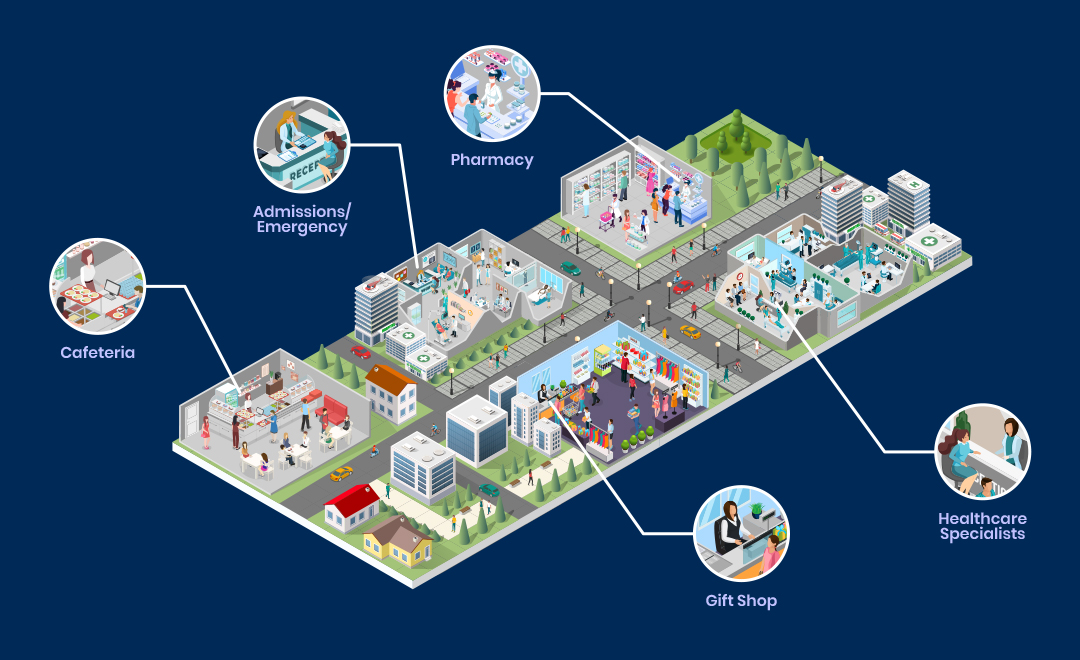The market for digital payments is exceeding expectations, growing from $111B in 2023 to an estimated $193B by 2028.
Digital payments are done through contactless payment terminals, smart devices, mobile phones, and laptops. Digital payment drivers include the increased adoption of smartphones, real-time and P2P payments, and a desire for greater convenience.
Embedded payments go hand in hand with digital payments. Payment processing is seamlessly integrated with the software system. This creates one brand and experience.
Digital payments are an integral aspect of embedded payments, as the embedded payment offering should be enabled for all digital payment types, across all payment ecosystem touchpoints.
Today we take a look at how embedded payments work across the healthcare ecosystem.
The Growth of Healthcare Touchpoints
Anyone who has visited a hospital or doctor’s office recently can attest that payment offerings are becoming more varied. Healthcare’s adoption of digital payments arguably began with the pandemic, when in-person visits ceased, telehealth began, and payments were made online.
Shoot to 2024. Patients have returned to healthcare offices, and the number of touchpoints has increased. This could be through an app, a website, or a live visit, and may include payments or just communication. From booking an appointment, to requesting medical advice, to filling out a survey, there are a myriad of “touches” in the patient’s experience.
Payments are being processed at many touchpoints. More providers are offering patient portal payments. Others are offering in-app or text-to-pay for bills. And in-person payments with a payment card terminal are predominant for office visits.
Payments can be accepted:
- Through a software system that specializes in a certain area of the hospital, such as the pharmacy
- As a broader software offering
- As a stand-alone solution provided directly by a payment processor.
“Perhaps the only good thing that came from COVID-19 was the evolution of virtual healthcare. Out of necessity, healthcare took a giant leap forward in digitizing patient care and payments, and as a result, this shift is shaping the future of healthcare and making technology a top priority,” said Ruston Miles, Payfactory’s CEO and founder of Bluefin Payment Systems. “To keep up with patient demand, healthcare organizations will need to provide more digital offerings.”
In fact, Onbe’s 2023 Fall Healthcare Payments Survey found that many physician practice groups are currently trying to figure out the right mix of payment forms to meet the needs of their patients. According to the survey:
- 77% of respondents said that making and receiving payments digitally would positively impact their relationship with their healthcare provider
- Medical refunds are especially ripe for digitization, with 59% of patients receiving payments via check despite the high costs, risk and decreasing popularity of this payment method
When considering an embedded payment strategy in healthcare, providers must answer the following:
1. What are the payment touchpoints? In the healthcare system, this would be where the payments are made.
2. How do patients like to pay at these touchpoints? There may be several ways to pay at one touchpoint. For an in-office visit, payment could be made with a physical credit card through contactless payments, or they could be made using a digital wallet with that same payment terminal.
3. What is the best software platform or payment processor to provide these payment types? A healthcare network could have a variety of software platforms and independent payment processors serving multiple touchpoints.
The Healthcare Payments Ecosystem
How embedded payments work in healthcare will differ with each provider and location. In Payfactory’s experience serving healthcare organizations, some of the most common payment touchpoints include:
– Admissions and emergency, where point-of-sale (POS) payment terminals equipped with contactless payments.
– Healthcare specialists, where mobile payments have become increasingly common, either before, during, or after an appointment.
– The cafeteria and gift shop, where POS payments are common for face-to-face transactions, and mobile / online payments could also be done for flower pickup or patient meal delivery.
– The pharmacy, where prescriptions can be paid for in-person or via mobile or online links.

Expertise in Embedded Healthcare Payments - Payfactory
Founded by CEO Ruston Miles in 2021, Payfactory specializes in embedded payment facilitation for software platforms across verticals. Ruston believed that payment facilitation would drive the future of payments with a seamless implementation and go-live experience for software platforms and merchants – but that security could not be compromised by increased speed and flexibility.
A member of the PCI Security Standards Council Board of Advisors since 2019, Ruston was at the forefront of developing North America’s first PCI-validated point-to-point encryption solution.
That’s why he designed Payfactory’s payment facilitation platform to include tokenization, E2EE, or P2PE – as well as customer authentication with 3D Secure (3DS) and additional fraud tools – as standard offerings through Payfactory and our partner gateways. This combination of embedded payments with security is crucial as healthcare continues to be targeted by cyberattacks.
Learn more about Payfactory’s platform or contact us to set up a consultation.
